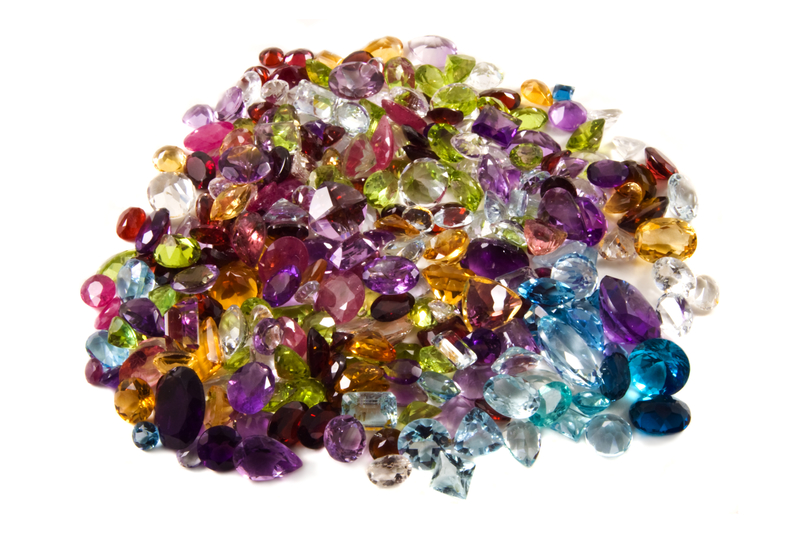Your basket is currently empty!

Calibration of gems
Calibrated gems in the jewellery industry are when gems are made available in standard sizes to simplify the design process for jewellers. For example: a jeweller knows when designing a ring that will be set with white round brilliant cubic zirconias, that they are available in sizes 1 mm, 1.25 mm, 1.5 mm, 1.75 mm, 2 mm etc. Cz’s are not made in random sizes and with variable proportions. The same goes for moissanite and other man-made gems.
Sizes of large natural gems
Natural gems are a bit more complicated. Expensive natural gems like diamonds, rubies, sapphires etc, or any gem crystal that is over a particular size or of exceptional quality, are cut to get the most valuable gem from the rough crystal. The aim of the gem cutter is usually to maximize on carat weight, or to work with the natural characteristics of the crystal, e.g. inclusions and phenomena, to get the most visually appealing result. This often means cutting it into a size that does not round up to the closest mm, or a shape that may not be the proportions of a perfect heart, marquise, oval etc.
The upshot is that jewellers can very often only design the jewellery item once he/she has the actual gems in hand. Only then can they measure the widths and depths of the gems and design their settings accordingly.
This may make it difficult to communicate with customers about the availability of large natural gems in a specific size for their custom designed item. The situation almost always arise where designs are discussed around approximate sizes, with the understanding that the jeweller will then try to source a gem from their suppliers as close as possible to what was discussed.
Note: Inconveniently, the cost of the gem is determined by its weight in carats, which also means that the final quote of the item can only be determined once the gems are in hand and can be weighed. If at this point the gem is too cheap or costly for the customer, the jeweller then has to go back to the dealer to check what else is available.
Both jewellers and gem dealers prefer to work in mm and not in carat weight when searching for a particular size natural gem. Two gems may have the same weight, but because the one is cut deeper than the other, the one will appear smaller when viewed from the top. Also, a 1 ct ruby will not be the same size as a 1 ct diamond, as the specific gravity (density) of ruby is higher than that of diamond. This means that a perfectly proportioned round cut 1 ct diamond will be larger than a perfectly proportioned round cut 1 ct ruby.
The following are comparative charts kindly supplied by Schreuders Gems. It shows how the carat weights differ between natural gems with the same dimensions in mm. It can also be used to determine the approximate carat weight of a gem for quoting purposes.
Round
[ninja_tables id=”585″]
Square
[ninja_tables id=”588″]
Oval
[ninja_tables id=”596″]
Marquise
[ninja_tables id=”598″]
Baguettes
[ninja_tables id=”599″]
Calibrated small natural gems
Smaller gem crystals are less rare than large gems, and they are often cut in calibrated sizes to make it easier for jewellers. Jewellery designs often require a few smaller gems in rows or patterns, or many small gems in pavé or channel settings, and they all need to be of a specific size for the design to work. In cases such as these it is convenient to know that peridots, garnets and topazes, for example, are usually available in round sizes in 0.5 mm increments between 2 mm and 5 mm.
Calibrated small diamonds
With very small diamonds, a jeweller will place an order for 1.3 mm stones, rather than referring to their size as 0.01 ct or 1 point. A 1 pt diamond that is cut very deep may not be exactly 1.3 mm in diameter, which becomes a problem when the design requires a row of uniformly sized stones.
Note: This is especially true today with the accuracy of CAD and producing jewellery through rapid prototyping. Where previously the setter would have cut seats for each stone individually, adjusting slightly in their spacing if their sizes are not quite the same, with CAD the computer places each gem perfectly in its seat and the same distance apart. Setting gems that differ in size, albeit slightly, into jewellery produced through CAD, can result in set work that looks very sloppy. Slightly smaller and larger gems tend to stand out like a sore thumb…
To conclude…
Gem dealers often have lists available of the calibrated sizes that their stock are available in. It is always useful to have a copy close when designing, and giving a copy to sales staff so that they can guide a customer correctly, both in terms of the availability of certain sizes and their cost.